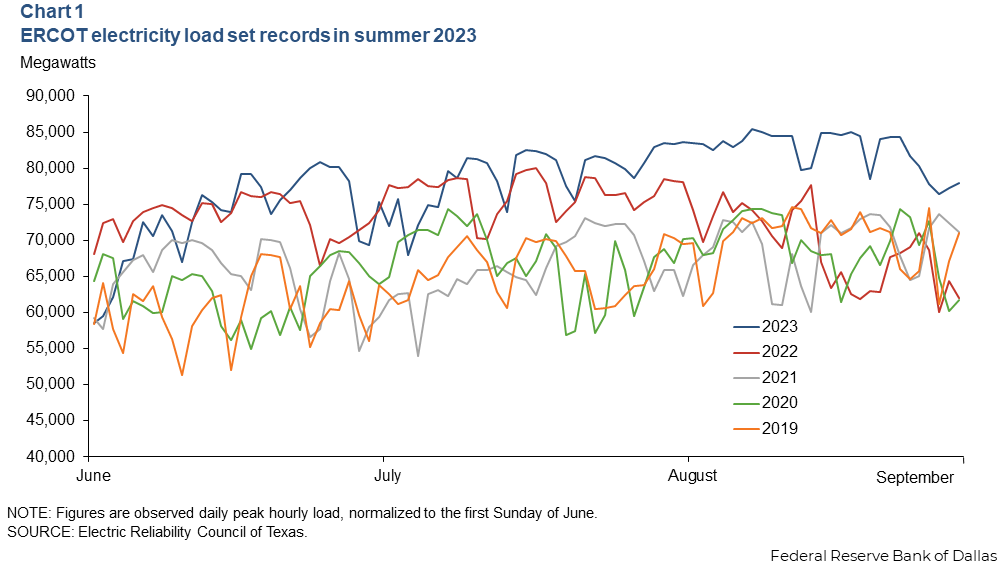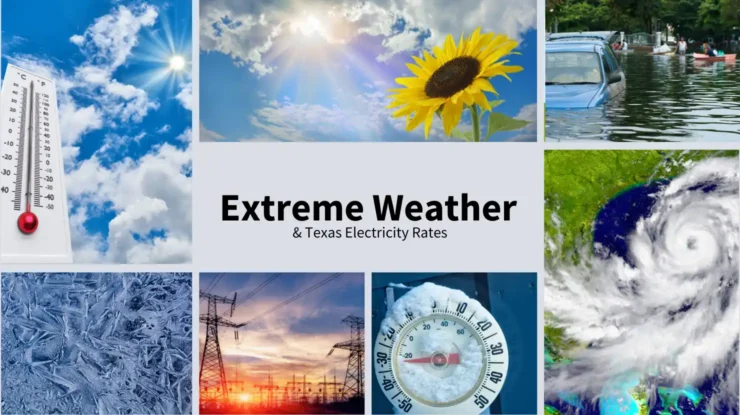Weather can significantly impact Texas electricity rates due to supply and demand. Warm weather drives high electricity usage for cooling homes and businesses. Cold weather extremes cause power usage to soar with demand for heat. Your best bet for electricity shopping is to avoid the seasonal extremes.
Key Takeaways
Weather extremes impact electricity prices.
- Extreme temperatures, both hot and cold, lead to increased electricity usage for heating and cooling, causing demand to surge.
- Adverse weather conditions can disrupt power generation. For instance, solar output decreases on cloudy days, wind turbines are less effective without wind, and natural gas plants can experience shutdowns during freezing conditions.
- When high demand coincides with constrained supply, electricity prices rise. Traders anticipate these conditions and adjust prices accordingly.
In this article:
- How Does Weather Impact Electricity Generation in Texas?
- How Does Weather Impact Electricity Demand?
- How Does Weather Impact Texas Electricity Rates?
- Fixed Rate Plans Protect You Against Weather Risk
>Read more on factors that impact electricity prices in our article on Texas electricity rate trends.
How Does Weather Impact Electricity Generation in Texas?
Weather can impact all forms of electricity production in Texas.
Solar production is impacted when the sun doesn’t shine. Wind production is impacted when the wind doesn’t blow. Utility scale battery storage helps to solve both those issues, but is still in its infancy.
Natural gas power plants aren’t immune from weather impacts. During Winter Storm Uri, freezing and fuel issues shut down multiple power plants.
ERCOT works with power generators on an annual, monthly and daily basis to evaluate supply availability, including the risk of outages. They can call on additional resources to generate power if needed, but this type of on-demand power is usually very expensive.
How Does Weather Impact Electricity Demand?
On a normal day, 20% of ERCOT load is residential electricity. But on a scorching hot day? Or a super cold day? Residential electricity jumps to almost 50% of the total ERCOT load.
That’s because around 30-50% of your home electricity bill is heating and cooling your home. Consumers demand comfort, which sends power use soaring.
ERCOT has some tools to manage demand. Large industrial customers participate in demand response programs, where they curtail power usage when ERCOT asks them to do so. Residential customers can also participate in programs that pay you to conserve energy, depending on your Retail Electricity Provider (REP).
The reality is, electricity demand in Texas is on a growth trajectory. And while population and business growth are part of it, economists highlight extreme weather as the key reason demand is so high.
For example, in 2023, the second hottest Texas summer on record, ERCOT experienced 42 days where demand exceeded 80,000 megawatts. It had never exceeded that level in the previous 5 years.

How Does Weather Impact Texas Electricity Rates?
But what you really want to know is, what about me? How does extreme weather in impact my Texas electricity rate?
Simple. Extreme weather in Texas drives electricity prices up.
This is based in the principles of supply and demand. When there are limited resources and demand exceeds supply, prices go up.
Electricity traders see weather forecasts and know that demand will spike. They know that there’s only so much power to go around. They begin buying power, which drives prices upward.
During extreme weather, the fixed rate offers that are available will be significantly higher priced.
Small independent REPs will increase prices faster than some of the mega-energy companies, who may face rounds of internal discussion. We’ve also seen some REPS stop accepting new customers during extreme weather events. That’s something we’ve seen more frequently since Winter Storm Uri in 2021.
TIP: The best time to shop for electricity is spring and fall. The worst time to shop for electricity is during the summer or winter. And the absolute worst time to shop for power is during any extreme weather event.
Shop Electricity Rates by Zip Code
Fixed Rate Plans Protect You Against Weather Risk
We recommend fixed rate plans to all of our customers. This is the best way way to protect yourself against weather risk.
If you are on a fixed rate electricity plan during an extreme weather event, you’re protected against price increases. With a fixed rate plan, your REP commits to a specific price per kWh for all of your power. They purchase an electricity contract in the wholesale market to back up your historical power consumption. And they deal with the headache of buying extra power when extreme weather makes your usage soar. But it’s not your problem because of your fixed rate plan. In other words, “not your circus, not your monkeys.”
If you are on a month to month variable rate during an extreme weather event, your rate will jump dramatically. After all, your rate can change each month, usually with no limits. And the REP will increase your price to recoup their energy costs. Shop as soon as possible after weather (and prices) return to normal.
If your contract expires during an extreme weather event, we recommend you sit tight. Yup. Don’t shop. Because a few days on a month to month variable rate with your current provider is likely cheaper than locking in a fixed rate contract at an inflated rate. Wait until weather (and prices) return to normal, then compare electricity rates online.
You can shop your Texas electricity rates by zip code using ElectricityPlans shopping tools. Or sign up for contract expiration reminders and never miss another renewal! Read our step-by-step guide to Texas electricity shopping for more tips.
